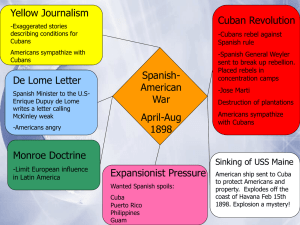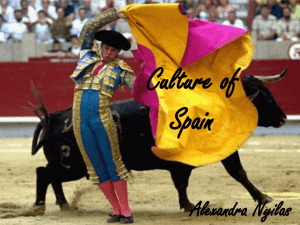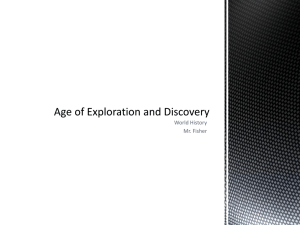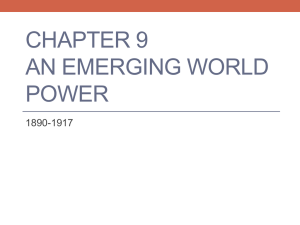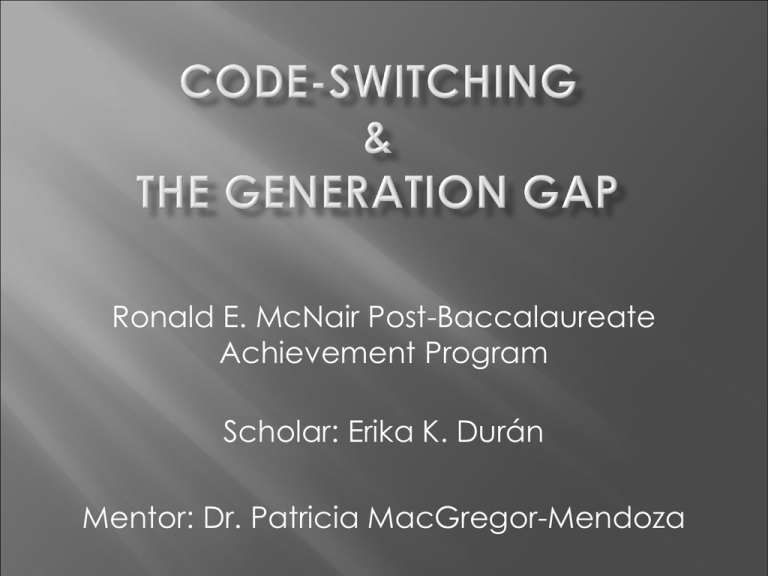
Ronald E. McNair Post-Baccalaureate
Achievement Program
Scholar: Erika K. Durán
Mentor: Dr. Patricia MacGregor-Mendoza
The transitioning back and forth
between two languages for
convenience, emphasis, humor, etc.
Code-Switching is not a linguistic
phenomenon,
but rather a psychological one
(Haugen 1954: 368).
Haugen also refers to ‘the codeswitching which occurs when a bilingual
introduces a completely unassimilated
word from another language into his
speech
(1956: 40).’
Started in the early
1950’s.
It was not Haugen who
used the term first, rather
Hans Vogt in an article in
1954.
*According to Peter Auer’s book
Code-Switching in Conversation
In 1952 Roman Jakobson established the
term’s success by drawing parallels between
language switching, co-existent phonological
systems in borrowing, and information
theory.*
*According to Peter Auer’s book
Code-Switching in Conversation
o
Pidgin-Creoles
o
Diglossia
o
Borrowing
o
Calques
People of lower status learn some words of
those in power; their children expand
these
words into a language.
A functional separation of language; one
language is used in certain places (e.g.
church) and another is used in other
places
(e.g. government offices).
A terms from another language and
changing the pronunciation.
(e.g. Cornfles, Peksi, Taco, Tortilla)
Translating phrases in one
language whose components
are translated into another
language.
(e.g. “blue blood” sangre azul.)
Hybrid Anglicization
Literal Translation
Literal (Wrong meaning)
Same Semantics
Borrowing
Phonological Similarities
English
Spanish
“Spanglish”
Population
Población
Populación
Doctor’s
office
Consultorios
Oficina del
doctor
Embarrassed
Vergüenza
Embarazada
Emergency
Urgencia
Emergencia
Pin
Alfiler
Pin
Library
Biblioteca
Librería
*Spanglish: An Anglicized Spanish Dialect By: Alfredo Ardila Hispanic Journal of Behavioral Sciences 2005;
I conducted a quantitative
study on how people of
different ages and genders
weave together
Spanish and English.
The research consisted of
5 females and 5 males from
each of two age groups;
(20 – 30 years old & 70 and
above).
The reasoning behind why
these age groups were
chosen was to compare
college age students
vs.
their grandparent’s age.
Seeing if the generation gap
effects their way of speaking.
Each informant was asked to
sign a consent form allowing
me to digitally record them.
They were also informed that
they will remain anonymous
and no one but myself will
listen to the recordings.
Each informant provided
a brief history on their
English/Spanish language
acquisition, proficiency,
and use.
Informant
Number
Place of
Birth
Education
1st Language
Spoke
1
2
3
4
5
6
7
8
9
10
11
12
US
MX
US
US
US
US
US
US
US
US
MX
MX
SomeCollege
SomeCollege
SomeCollege
College
College
SomeCollege
HS
SomeHS
SomeCollege
College
SomeCollege
SomeCollege
Both
Both
Spanish
Spanish
Spanish
Both
Spanish
Spanish
English
English
English
Spanish
1st
Language
Read
1st
Language
Write
English
English
English
English
English
English
Spanish
Spanish
English
English
English
Both
English
Both
English
English
English
English
English
English
English
English
English
Both
The informants were asked to orally narrate
Frog Where are you?, by Mercer Meyer,
a book without words. They were asked to
recited the story switching between
Spanish and English.
Informant
Number
Age
Sex
1
2
3
4
5
6
7
8
9
10
22
22
22
24
23
78
76
73
20
29
F
F
F
F
F
M
F
M
M
M
Total
Total
Total
Total Switches
Total
Total
Total Words in Words in Switches to
Total
Total Smooth Rough
Words English Spanish to English Spanish Borrowed Calques Switches Switches
467
182
721
412
324
732
395
627
285
645
299
87
434
254
56
342
221
1
154
591
168
95
287
158
268
390
174
626
131
54
10
13
8
5
10
35
18
1
29
23
11
12
9
5
9
36
19
1
29
24
*Frog Where are You? Results
1
1
0
2
1
0
0
0
0
0
0
0
0
0
0
4
2
2
0
0
9
18
5
9
12
26
17
1
16
19
4
0
11
1
7
8
8
0
19
5
They were also asked to retell
the story of La Llorona or
another fairy tale that they
remembered, also switching
between
Spanish and English.
Informant
Number
Age
Sex
1
2
3
4
5
6
7
8
9
10
22
22
22
24
23
78
76
73
20
29
F
F
F
F
F
M
F
M
M
M
Total
Total
Total
Total Switches
Total
Total
Total Words in Words in Switches to
Total
Total Smooth Rough
Words English Spanish to English Spanish Borrowed Calques Switches Switches
258
215
132
227
198
191
167
44
115
297
187
140
73
112
167
188
78
3
75
236
71
70
59
115
31
3
89
41
39
61
14
6
2
4
3
2
1
1
9
9
*La Llorona Results
14
7
2
4
3
2
1
1
10
10
2
1
1
0
1
2
0
0
3
6
1
1
0
0
0
0
1
0
0
1
19
12
3
6
5
3
2
2
11
15
9
1
1
2
1
1
0
0
8
4
o
o
Seek patterns of their linguistic behaviors,
exploring different informants’ use of codeswitching, borrowing, and calques.
Examine the patterns to see if there are
any similarities or differences between how,
where, and what elements of their speech
are used in Spanish or English and if these
speech patterns are the same or different
between genders and across age groups.
"Our language is the reflection
of ourselves. A language is an
exact reflection of the character
and growth of its speakers.“
~Cesar Chávez




